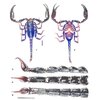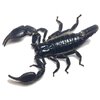Outpost31Survivor
Arachnoprince
- Joined
- Aug 23, 2019
- Messages
- 1,655
Six new Heterometrus species may have been discovered:
Heterometrus atrascorpius 2012 - India
Heterometrus liangi 2007**** - Vietnam
Heterometrus minotaurus 2016 - Thailand
Heterometrus telaganaensis 2010 - India
Heterometrus tibetanus 2005 - Tibet
Heterometrus yaleenis 2019 - Sri Lanka
**** As of 2017, species requires a confirmation of its validity. I can't wait for Prendini's update on the Heterometrus genus.
Heterometrus atrascorpius 2012 - India
Heterometrus liangi 2007**** - Vietnam
Heterometrus minotaurus 2016 - Thailand
Heterometrus telaganaensis 2010 - India
Heterometrus tibetanus 2005 - Tibet
Heterometrus yaleenis 2019 - Sri Lanka
**** As of 2017, species requires a confirmation of its validity. I can't wait for Prendini's update on the Heterometrus genus.
Last edited:












